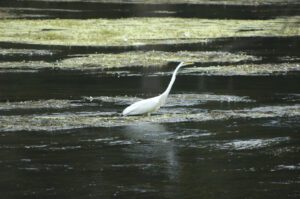You can find this post on Substack as well.
 This week we’ve finally gotten appreciable rain where I live. It’s been months. Fortunately we avoided the flooding rains that people not that far to the south of me have endured. According to the National Weather Service, we’ve been in “exceptional” drought. The grass hasn’t grown. Trees have been dropping their leaves since late July or early August. The last time I cut my grass was June.
This week we’ve finally gotten appreciable rain where I live. It’s been months. Fortunately we avoided the flooding rains that people not that far to the south of me have endured. According to the National Weather Service, we’ve been in “exceptional” drought. The grass hasn’t grown. Trees have been dropping their leaves since late July or early August. The last time I cut my grass was June.
We normally have lots of birds in our yard. I feed them all winter and provide a fallow area where they live and build nests. On a typical evening, I can identify 10 or more species of birds.
But not this summer. There are a few, but most seem to have moved on in search of water. The Elk River is a couple miles away. The ground is too hard for them to find worms. There aren’t as many bugs crawling around or flying through the air.
I’ve watched the news all summer and marveled at our dry air and heat while other parts of the country have been slammed with floods. (Everyone has been hot.)
As the planet continues to warm, weather patterns are set to change. Some places we live now will become unlivable and temperate areas will be hotter and drier.
Many of my novels involve current events, history and science. I might make up places and people, but the science is all real. I don’t write science fiction, but scifi is often about extrapolation — taking what we have and wondering what it will look like in the future. Think about Dick Tracy’s watch or tricorders and tablets on Star Trek.
The major theme of Water Crisis: Day Zero is, obviously, water. I wrote this book a few years ago, inspired by a situation in Cape Town, South Africa where the city of more than 4.5 million people was within just a few days of running out of fresh water — its Day Zero. Researching deeper, I found that wasn’t an unusual scenario and civil wars have even started over fresh water resources.
That’s where water refugees move to cities to get access to fresh water, putting strains on city services, leading to uprisings. The civil war in Syria is an example of this.
But it’s not just in desert climates. Fifteen plus years ago, I was living in Durham, North Carolina when the local water reservoir was within a couple weeks of running out of water. A tropical storm hit the Carolina coast and in one weekend, everything was back to normal.
About two weeks ago, a small community in West Virginia — Richwood — was within a few days of running out of freshwater. The Cherry River was down because of the drought. The city managers were even contemplating using water in a fracking well — if the radioactive levels in the water tested low enough.
This week, suddenly, we got more rain than was even forecast, even before Helene slammed into Florida hard enough that it brought heavy rain to the southern Appalachian mountains. Everything is back to normal.
Water out west is a prime commodity. The Colorado River doesn’t make it to the ocean any more. I saw a photo recently showing an area in the San Joaquin Valley in California where the official elevation had dropped dozens of feet because the water table below ground has been pumped out for agriculture.
The point of all this is, some people don’t believe in sea level rise or even climate change. But it’s hard to ignore things like running out of water when it is right in front of your face.